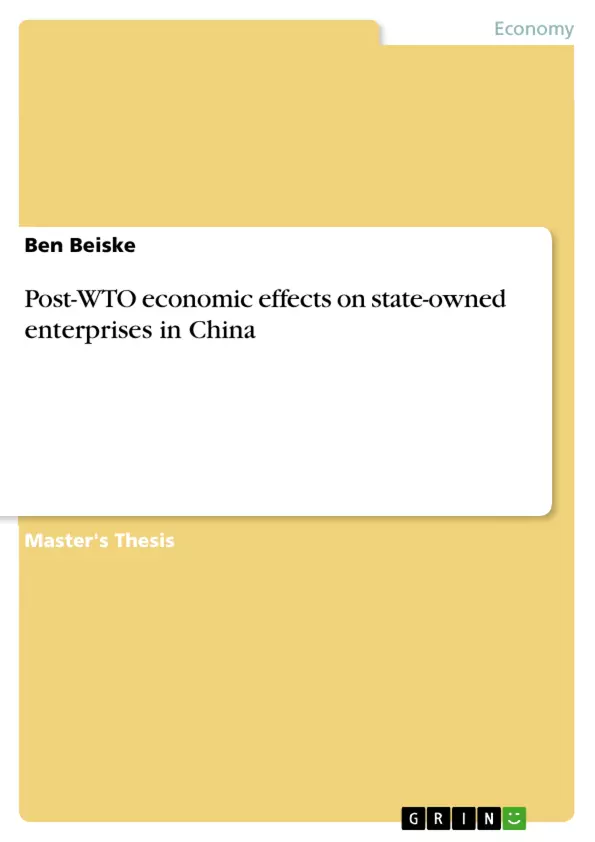The importance of the World Trade Organisation (WTO) for international free trade today has enticed China to join the WTO in December 2001. The significance of WTO membership for China cannot be underestimated, inevitably speeding up much-needed economic reform in the country. The gradual transition from a planned- to a market-economy is expected to continue in the future. The severity of the impacts for the economy will depend on how successful China is in providing policies that will assist the nation in the major adjustment problems that it faces in the future.
The expected, actual, and needed implications for China’s state-owned enterprises (SOEs) resulting from WTO membership will be investigated in detail; in the process, the significance of SOEs to the Chinese economy will be highlighted. SOEs are mostly ill- prepared for a post-WTO China, and the dismal state of these companies has already led to the decline of market share in the past decade. For the future, the retreat of the state is likely to continue. The main implications for SOEs from China’s WTO membership are seen in the areas of competitiveness, corporate governance, privatisation, mergers and acquisitions, property rights, unemployment, and attracting and retaining qualified personnel.
This dissertation offers one of the most detailed insights into the challenges facing China’s SOEs and the implications of China’s WTO membership for these companies, while also highlighting the areas that require future attention. The understanding of the role and meaning of SOEs for the Chinese economy is of immense importance for foreign investors wanting to invest in the country, already cooperating with China’s SOEs, or looking into the possibility of such.
Inhaltsverzeichnis (Table of Contents)
- Introduction
- The Role of State-Owned Enterprises in China
- Pre-WTO Situation
- The Reform of SOEs
- SOEs and Market Transition
- WTO Membership and China's Economy
- Implications of WTO Membership for SOEs
- Competitiveness
- Corporate Governance
- Privatisation
- Mergers and Acquisitions
- Property Rights
- Unemployment
- Attracting and Retaining Qualified Personnel
- Conclusion
Zielsetzung und Themenschwerpunkte (Objectives and Key Themes)
This dissertation investigates the post-WTO economic effects on state-owned enterprises (SOEs) in China. The primary objective is to analyze the challenges facing SOEs in a post-WTO environment and explore the implications of China's WTO membership for these companies. The dissertation also highlights areas requiring future attention, particularly in the context of China's economic transition and its impact on SOEs.
- The significance of SOEs to the Chinese economy
- The impact of WTO membership on SOE competitiveness
- The challenges of corporate governance and privatization in SOEs
- The role of mergers and acquisitions in the restructuring of SOEs
- The implications of WTO membership for unemployment and skilled workforce retention in SOEs
Zusammenfassung der Kapitel (Chapter Summaries)
The introductory chapter provides an overview of the research topic and its significance. It explores the role of SOEs in the Chinese economy and the challenges they face in a post-WTO environment. The second chapter delves into the pre-WTO situation of SOEs, examining their historical context and the reforms undertaken in the transition to a market economy. It also explores the implications of WTO membership for China's economic development. The third chapter focuses on the implications of WTO membership for SOEs. It analyzes the impact on competitiveness, corporate governance, privatization, mergers and acquisitions, property rights, unemployment, and the attraction and retention of qualified personnel.
Schlüsselwörter (Keywords)
This dissertation focuses on the post-WTO economic effects on state-owned enterprises (SOEs) in China, exploring their challenges, implications, and future prospects. Key themes include: SOE reform, market transition, competitiveness, corporate governance, privatization, mergers and acquisitions, property rights, unemployment, attracting and retaining qualified personnel, and the significance of SOEs to the Chinese economy.
- Citation du texte
- Ben Beiske (Auteur), 2003, Post-WTO economic effects on state-owned enterprises in China, Munich, GRIN Verlag, https://www.grin.com/document/17800



